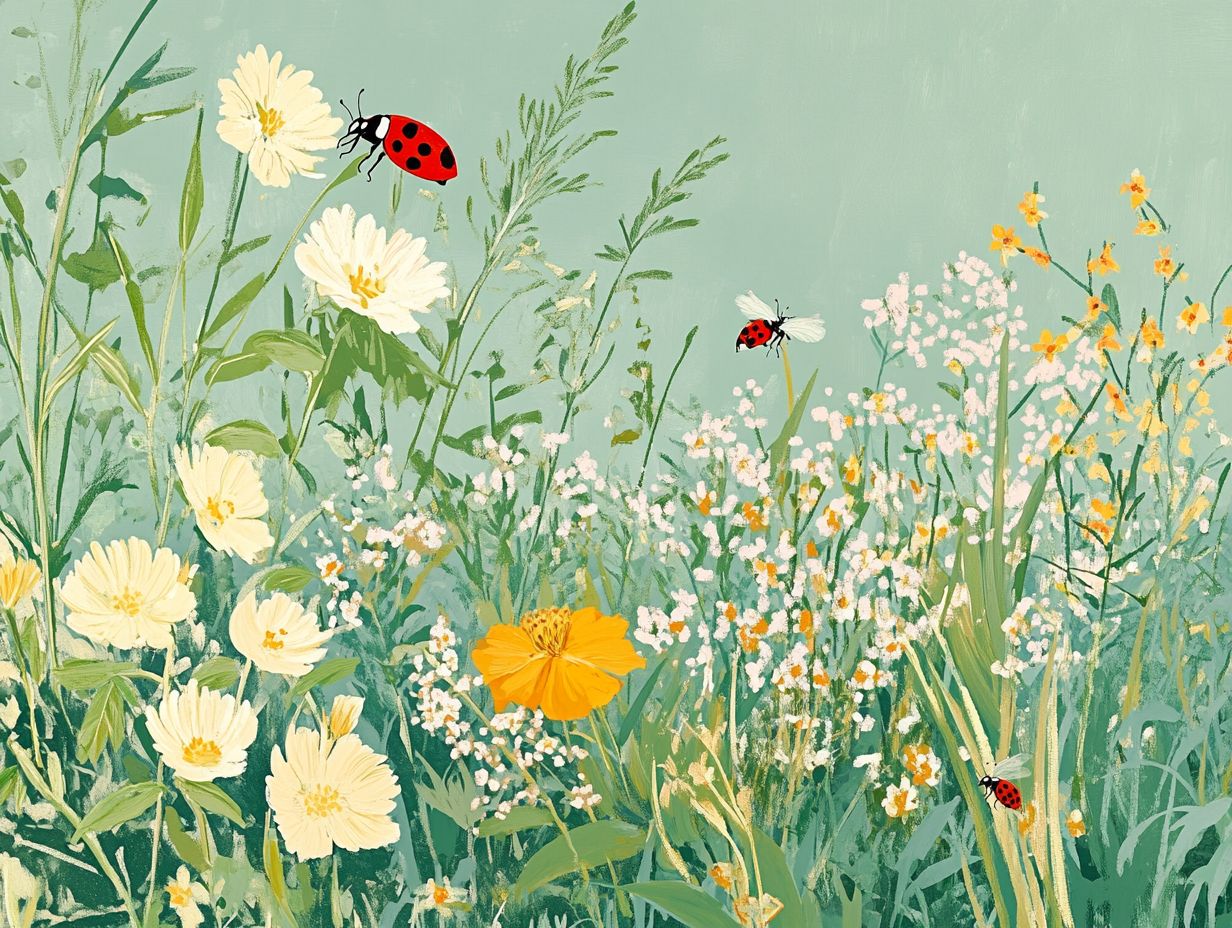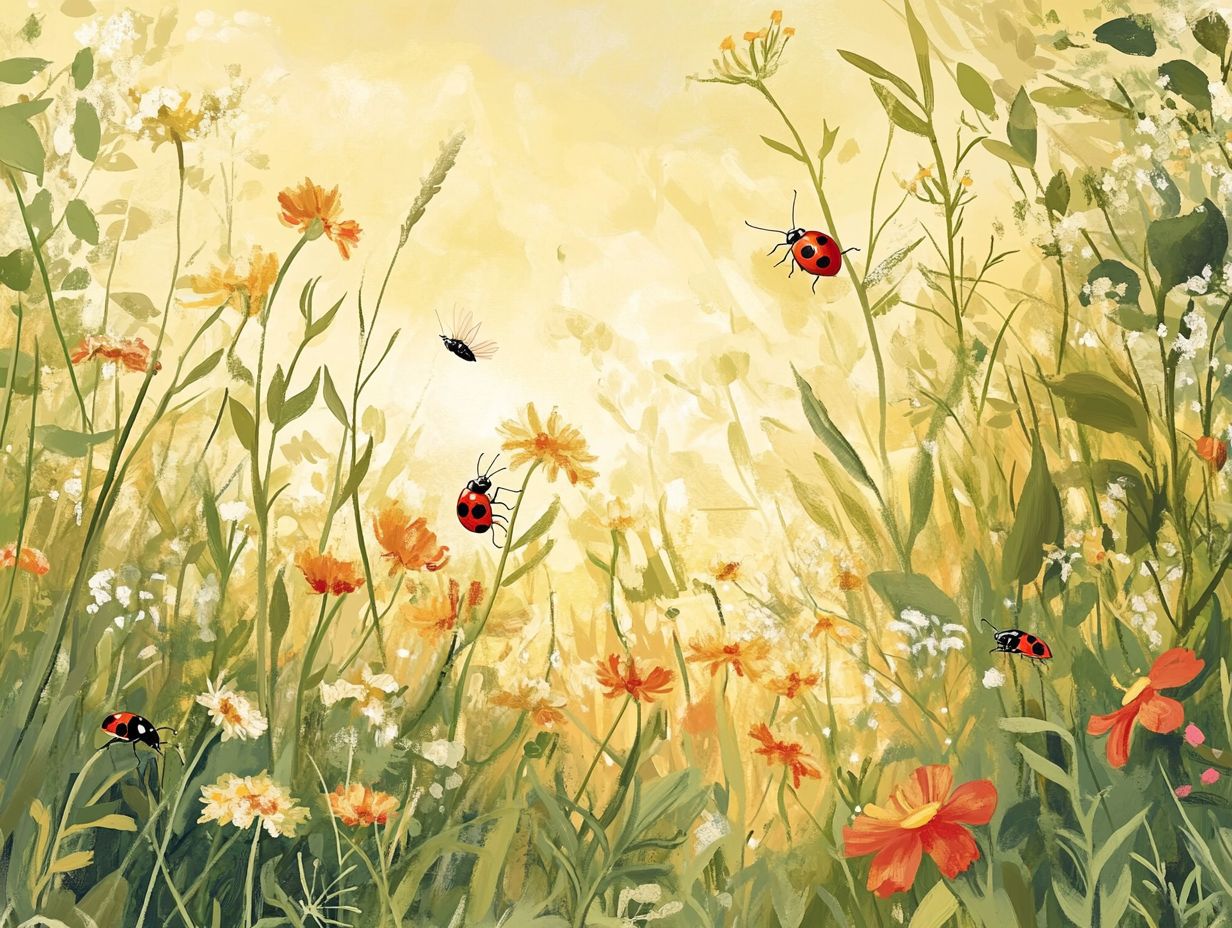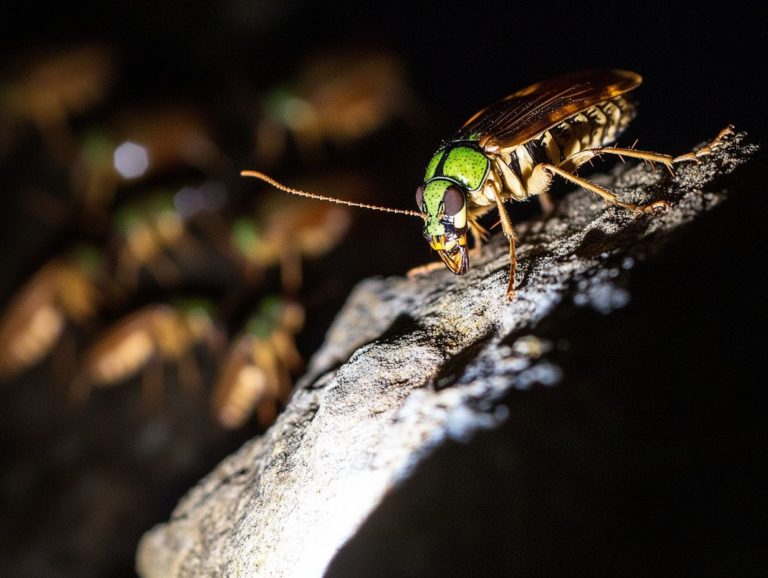How to Encourage Predatory Insects
Predatory insects are essential for maintaining the vitality of your gardens and farms, serving as nature s own pest control agents. By recognizing their importance, you can cultivate environments that attract these beneficial creatures.
This article delves into practical strategies for nurturing beneficial insects, including how to design suitable habitats and select the right plants. You will learn about companion planting, which is planting different crops together to enhance growth and pest control, natural pest control methods, and the common beneficial species that can help you establish a thriving ecosystem in your garden. Discover how these tiny allies can transform your gardening and farming experience!
Contents
- Key Takeaways:
- The Importance of Beneficial Insects
- Attracting Beneficial Insects
- Using Companion Planting
- Natural Pest Control Methods
- Common Predatory Insects and Their Characteristics
- Tips for Maintaining a Balance of Predatory Insects
- Frequently Asked Questions
- What are predatory insects and why are they beneficial for pest control?
- How can I attract predatory insects to my garden or farm?
- What types of plants can I grow to attract predatory insects?
- How can I use companion planting to encourage predatory insects?
- What are some other ways to encourage predatory insects?
- Are there any drawbacks to encouraging predatory insects?
Key Takeaways:

- Encouraging beneficial insects can greatly benefit gardens and farms by controlling pests naturally.
- Creating a suitable habitat and choosing the right plants attract these insects to your garden.
- Using companion planting and natural methods helps maintain a balance of beneficial insects.
The Importance of Beneficial Insects
Beneficial insects are essential in safeguarding the vitality of your gardens and farms by naturally managing pests that threaten your crops and flowering plants. By inviting insects like ladybirds, hoverflies, parasitic wasps, and ground beetles into your space, you can greatly reduce your dependence on chemical insecticides, promoting organic pest control methods.
The U.S. Department of Agriculture emphasizes that these beneficial insects play a vital role in maintaining balanced ecosystems and enhancing biodiversity, underscoring their significance in sustainable gardening practices.
Why They Are Beneficial for Gardens and Farms
Beneficial insects are essential for effective pest control in your garden or farm. They actively prey on harmful pests like aphids, significantly reducing your reliance on synthetic pesticides and promoting organic pest control.
Among these invaluable allies are lacewings, whose larvae feast on a wide variety of damaging insects, helping to maintain a natural balance within your ecosystem. Solitary bees also play a crucial role in pollination, ensuring your flowering plants thrive and produce fruit, further supporting the overall health of your garden and attracting more beneficial insects.
Then there are tachinid flies, another key player; their larvae invade and decimate pest populations, contributing significantly to your organic pest management strategies. By harnessing the powers of these beneficial insects, you enhance your garden’s effectiveness and promote biodiversity, a vital component for long-term ecological stability.
Attracting Beneficial Insects
Attracting beneficial insects to your garden is a pivotal move in crafting a self-sustaining ecosystem. By incorporating diverse plantings that offer food, water, and shelter, you create an inviting space for these essential allies in pest control.
Consider adding flowering plants that produce nectar and pollen; they will beckon beneficial insects like hoverflies, ladybirds, and parasitic wasps to your garden. Establishing a suitable habitat for these insects enhances biodiversity and strengthens the natural balance of your ecosystem, leading to healthier plants and a decrease in pesky pests.
Creating a Suitable Habitat
Creating a suitable habitat for beneficial insects means ensuring they have the essential elements they need: food, water, and shelter. These factors are crucial for their survival and effectiveness in pest control.
You can significantly enhance these habitats by integrating diverse strategies. Installing water sources, like small ponds or birdbaths, will keep them hydrated. Using mulch retains moisture and offers a safe haven for many species. Incorporating native plants ensures these insects have readily available shelter.
These native plants provide refuge and contribute to a vibrant ecosystem by achieving continuous blooms throughout the growing season, offering a steady supply of nectar and pollen. By employing these interconnected methods, you nurture a robust environment where beneficial insects can flourish, ultimately supporting the health of your surrounding plants and crops.
Choosing the Right Plants for Your Garden

Selecting the right plants is key to attracting beneficial insects. Flowers like marigold, dill, and yarrow draw predatory insects such as lady beetles, making them essential for your garden.
Lavender and fennel provide delicious nectar and attract vital pollinators. Buckwheat draws pests away from your vulnerable plants, and sunflowers create cozy homes for ladybugs and lacewings, which eat aphids.
Imagine cultivating a thriving ecosystem! By thoughtfully incorporating a variety of these plants, you can enhance the health and biodiversity of your garden.
Using Companion Planting
Companion planting pairs compatible plants. This boosts growth and protects crops from pests.
This method creates a natural pest control system that draws in predatory insects, ensuring your garden thrives in harmony with nature.
Plants that Attract Predatory Insects
Some plants are superb at attracting beneficial creatures. Dill, fennel, and yarrow release scents or nectar that pull in helpful insects.
For instance, hoverflies are attracted to flowering herbs like dill, which provide nourishment for adults and habitat for larvae to feast on aphids. Meanwhile, yarrow beckons ladybugs, offering them a safe haven as they munch on aphids and other harmful insects.
Incorporating such plants enhances your garden’s beauty and fosters a balanced ecosystem, supporting predator populations that naturally keep pests in check.
Natural Pest Control Methods
Natural pest control methods, like using predatory insects, offer a sustainable alternative to chemical insecticides. Embracing these strategies helps keep your garden healthy and vibrant.
This approach promotes ecological balance while aligning with healthier gardening practices, reducing reliance on chemical insecticides.
Using Predatory Insects as a Natural Alternative
Using predatory insects is an effective way to manage pests naturally. Ladybugs, lacewings, and predatory mites thrive in gardens and help control aphid, spider mite, and whitefly populations.
To seamlessly incorporate them into your gardening routine, consider these approaches:
- Plant nectar-rich flowers that draw in these helpful species.
- Directly release commercially available predatory insects into your garden.
This method not only enhances plant health but also cultivates a vibrant ecosystem, enriching biodiversity and soil vitality while protecting beneficial pollinators from toxic chemicals.
Other Methods for Controlling Pests

In addition to using predatory insects, there are several other methods to control pests naturally, all while enhancing the overall health of your garden ecosystem.
Encouraging beneficial insects like ladybugs and lacewings can help control garden pests. Natural repellents like neem oil or garlic spray also deter invaders without harming the environment.
Implementing diverse plantings not only attracts these helpful creatures but also disrupts pest life cycles. Combine these techniques to create a balanced ecosystem that helps keep pests away and promotes plant health, ultimately leading to a more vibrant and resilient garden.
Common Predatory Insects and Their Characteristics
Understanding common predatory insects and their characteristics is crucial for you as a gardener aiming to leverage their benefits for effective pest control.
Each species contributes uniquely to the ecosystem, enhancing your gardening efforts in ways you might not yet realize.
Identifying and Understanding Different Species
Identifying and understanding the various species of beneficial insects is essential for effective pest management in your garden. This knowledge enables you to recognize your allies and adapt your practices to create a thriving ecosystem.
By paying attention to key characteristics such as size, color, and unique markings, you can easily distinguish between helpful insects and harmful pests.
For example, ladybugs, with their striking red shells and distinctive black spots, are your allies in the battle against aphids. Meanwhile, lacewings, known for their delicate, translucent wings, play a crucial role in controlling whiteflies and other soft-bodied pests.
It’s also important to consider the preferred habitats of these beneficial species. Many flourish in areas abundant with flowers or diverse vegetation. Incorporating visuals or simple diagrams that showcase these insects alongside the pests they combat can significantly enhance your identification skills, making your garden management both efficient and organic.
Tips for Maintaining a Balance of Predatory Insects
Maintaining a balance of predatory insects in your garden is essential for optimizing their pest control capabilities. Overpopulation can throw the delicate ecosystem off-kilter, jeopardizing the very conditions that allow them to thrive.
By carefully managing their numbers, you can harness their natural prowess while preserving the harmony of your garden.
Preventing Overpopulation and Ensuring Effectiveness
Preventing overpopulation among predatory insects is crucial for maintaining their effectiveness in controlling garden pests. When these populations go unchecked, the benefits diminish, leading to potential ecosystem imbalance.
To effectively manage these populations, you must implement regular monitoring practices. This involves keenly observing insect activity and identifying signs of overgrowth, such as an abundance of newly laid eggs or a sudden drop in pest populations.
Creating a diverse environment promotes a balance between different species, fostering natural competition that keeps any one group in check. Employing companion planting not only enhances biodiversity but also attracts beneficial insects that assist in regulating the numbers of predatory insects. This strategy helps prevent a scenario where their population overwhelms the ecosystem, ultimately safeguarding your pest control efforts.
Frequently Asked Questions

What are predatory insects and why are they beneficial for pest control?
Predatory insects are natural enemies of pests, such as ladybugs, lacewings, and praying mantises. They are beneficial for pest control as they prey on and help regulate the population of harmful pests in your garden or farm.
How can I attract predatory insects to my garden or farm?
Create a diverse habitat. Include native plants, cover crops, and reliable water sources.
Avoid pesticides, and ensure there are places for them to nest and lay eggs.
What types of plants can I grow to attract predatory insects?
Grow plants with small flowers, like dill, fennel, and yarrow.
Flowering herbs, such as mint and cilantro, along with native wildflowers, will create an attractive space for these helpful insects.
How can I use companion planting to encourage predatory insects?
Companion planting means growing plants together for mutual benefits.
By mixing flowers and herbs with your vegetables, you not only attract predatory insects but also provide them with food.
What are some other ways to encourage predatory insects?
You can also buy predatory insects from reputable suppliers.
Provide food sources like pollen and nectar, and cut back on pesticides to create a welcoming environment.
Are there any drawbacks to encouraging predatory insects?
Predatory insects are great for pest control, but they can sometimes eat beneficial insects too.
Learn to identify pests versus friends in your garden. Be cautious when introducing non-native species to maintain a balanced ecosystem.






